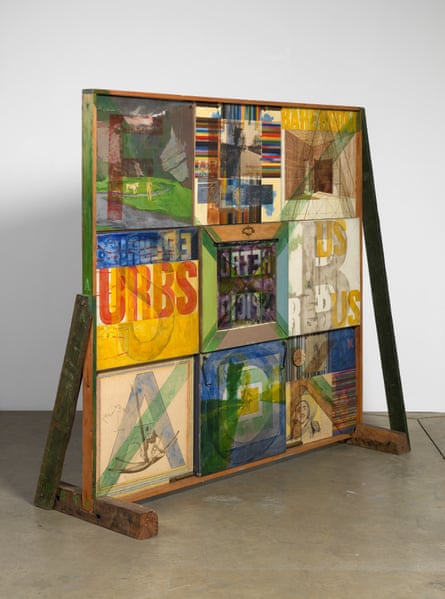John Furnival obituary

John Furnival in 2011. Towers (the Tower of Babel especially) and mazes were his recurring themes, as were witty imagery and verbal gymnastics
John Furnival, who has died aged 87, was a leading figure in visual and concrete poetry from the 1960s onwards, even as he often questioned with vigour the usefulness of these terms.
He described himself, characteristically tongue-in-cheek, as a “drawer”, his preferred medium being pen and ink. His “wordscapes” were made by drawing letters, words, phrases and long passages directly on to paper, card or painted panels. Towers (the Tower of Babel especially) and mazes were his recurring themes, as were witty imagery and verbal gymnastics.
He deplored the idea that anything he produced should be categorised as a “masterpiece”, yet he acknowledged the importance of his kinetic sculpture Devil Trap (1965) and the series of screens he made from 1965 to 2015, including Europa and her Bull (1966).
However, even the slightest item was significant to him and whatever came to hand – envelopes, food labels or commercial documents – often ended up within an artwork or as part of mailart (an experimental form where art is made in the form of a letter or package to be posted out rather than exhibited in a traditional context). The principle was simply “waste not, want not”.

Devil Trap, 1965, by John Furnival
Performance and music were crucial to his thinking. The composer Erik Satie was one of his key influences and, in 1975, Furnival co-opted a variety of artists and musicians to form the group Satie’s Faction, to produce work fusing music, words and performance.
John was born in Brockley, south London. His father, also John, was a printer, and his mother, Ivy, a teacher of ballroom dancing. John attended Haberdashers’ Aske’s school, Hatcham, but its motto, Serve and Obey, never sat well with him. Though encouraged by his teachers to study languages at university, he decided to become an artist and went to Wimbledon School of Art (1951-52).
During his subsequent national service, his linguistic skills took him to the War Office, translating Russian documents. In 1957, he arrived at the Royal College of Art, where he shared the emerging pop aesthetic but also began producing large-scale, architectural drawings that questioned the “rules” of perspective. One of his student works, Rooftops of Kensington Gore, hung for many years in the V&A restaurant.
In 1960 John won a British Council Rome scholarship, but instead of taking it up he moved to Gloucestershire, alerted by the artist Michael Shinn to a teaching vacancy at Cheltenham Art School; he also then taught at Stroud Art College. He married Astrid Belling in the same year, and they settled in an isolated cottage above the Cotswold town of Nailsworth. There they worked and gardened, enjoyed good food and wine, and relished the company of visitors.

Europa and Her Bull, 1966, by John Furnival.
John began teaching at the Bath Academy of Art, which was then based in Corsham, Wiltshire, in 1965. He remained at the academy (continuing after its return to Bath as the Bath School of Art and Design) for 35 years, becoming one of its best loved artist-teachers.
John and his colleagues, including Tom Phillips, Hansjörg Mayer and Ron King, shared ideas about how images and words elide and collide. They adopted unorthodox teaching methods – such as using John’s “feely boxes” to test their intuitive tactile responses to objects, or forming groups with little or no musical training to perform improvisations – that raised eyebrows with administrators; and adapted traditional media, such as print and books, into new forms, including kinetic machines and multimedia performance.
The Furnivals’ hospitality also led to working relationships. In 1963, the Benedictine monk and artist Dom Silvester Houédard (AKA dsh) visited from Prinknash Priory, where he produced his experimental “typstracts” (images made through typewriting). John and dsh, with Edward Wright, founded Openings in 1964 as a specialist press for the dissemination of concrete and visual poetries.

Flashback, 1972/76, by John Furnival. Photograph: Todd-White/Courtesy British Council collection
GLOUP (the GLOUcestershire grouP) emerged in 1974, initially comprising John, dsh, and the kinetic poetry sculptor Kenelm Cox. All lived in or near Nailsworth. John also collaborated on “one off” print, drawing and book projects with others experimenting with word and image, such as Ian Hamilton Finlay, Anselm Hollo, Thomas Meyer and Jonathan Williams. Nailsworth consequently became for a significant period a centre for the world of concrete and visual poetry.
John featured in numerous surveys of visual and concrete poetry, from the international exhibition Experimental Poetry in Oxford (1965) to The New Concrete: Visual Poetry in the 21st Century at the South Bank Centre (2015). His work is held in collections including Tate, V&A, Arts Council, British Council, Getty and the Sackner Archive of Concrete and Visual Poetry. His last exhibition travelled in 2019 from Stroud and Nailsworth to Bath, via Venice.
John suffered from the effects of a stroke in the last few years of his life. With unflagging purpose, he counted himself lucky that his “working” side was unaffected. He made new works on a daily basis. He titled a final group of pieces the Wittgenstein Series from the philosopher’s description of a cube emerging from the floor.
John is survived by Astrid and their children, Eve, Jack, Harry and Claudia, and grandchildren, Joe, Martha, Dora and Lucas.
• John Furnival, artist, born 29 May 1933; died 31 May 2020
———————————————————————————————————————————————-








With thanks to Harry Furnival
Dear friends of John,

I’ve just come across this, Harry and Jack, looking for you two, having found some old photo of Harry when we worked together.
Sorry to hear about John; gosh, he lived life to the full!
I’d love you to make contact with me,
Comment by Jamie Vans on 3 September, 2020 at 2:09 pmJamie